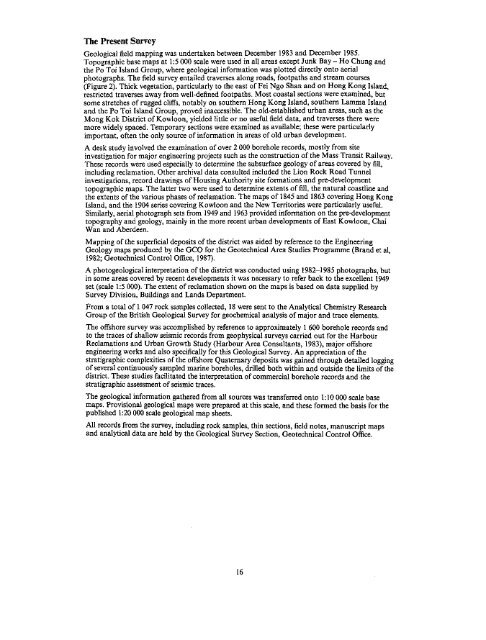Superficial Geology
Superficial Geology
Superficial Geology
You also want an ePaper? Increase the reach of your titles
YUMPU automatically turns print PDFs into web optimized ePapers that Google loves.
The Present Survey<br />
Geological field mapping was undertaken between December 1983 and December 1985.<br />
Topographic base maps at 1:5 000 scale were used in all areas except Junk Bay - Ho Chung and<br />
the Po Toi Island Group, where geological information was plotted directly onto aerial<br />
photographs. The field survey entailed traverses along roads, footpaths and stream courses<br />
(Figure 2). Thick vegetation, particularly to the east of Fei Ngo Shan and on Hong Kong Island,<br />
restricted traverses away from well-defined footpaths. Most coastal sections were examined, but<br />
some stretches of rugged cliffs, notably on southern Hong Kong Island, southern Lamma Island<br />
and the Po Toi Island Group, proved inaccessible. The old-established urban areas, such as the<br />
Mong Kok District of Kowloon, yielded little or no useful field data, and traverses there were<br />
more widely spaced. Temporary sections were examined as available; these were particularly<br />
important, often the only source of information in areas of old urban development.<br />
A desk study involved the examination of over 2 000 borehole records, mostly from site<br />
investigation for major engineering projects such as the construction of the Mass Transit Railway.<br />
These records were used especially to determine the subsurface geology of areas covered by fill,<br />
including reclamation. Other archival data consulted included the Lion Rock Road Tunnel<br />
investigations, record drawings of Housing Authority site formations and pre-development<br />
topographic maps. The latter two were used to determine extents of fill, the natural coastline and<br />
the extents of the various phases of reclamation. The maps of 1845 and 1863 covering Hong Kong<br />
Island, and the 1904 series covering Kowloon and the New Territories were particularly useful.<br />
Similarly, aerial photograph sets from 1949 and 1963 provided information on the pre-development<br />
topography and geology, mainly in the more recent urban developments of East Kowloon, Chai<br />
Wan and Aberdeen.<br />
Mapping of the superficial deposits of the district was aided by reference to the Engineering<br />
<strong>Geology</strong> maps produced by the GCO for the Geotechnical Area Studies Programme (Brand et al,<br />
1982; Geotechnical Control Office, 1987).<br />
A photogeological interpretation of the district was conducted using 1982-1985 photographs, but<br />
in some areas covered by recent developments it was necessary to refer back to the excellent 1949<br />
set (scale 1:5 000). The extent of reclamation shown on the maps is based on data supplied by<br />
Survey Division, Buildings and Lands Department.<br />
From a total of 1 047 rock samples collected, 18 were sent to the Analytical Chemistry Research<br />
Group of the British Geological Survey for geochemical analysis of major and trace elements.<br />
The offshore survey was accomplished by reference to approximately 1 600 borehole records and<br />
to the traces of shallow seismic records from geophysical surveys carried out for the Harbour<br />
Reclamations and Urban Growth Study (Harbour Area Consultants, 1983), major offshore<br />
engineering works and also specifically for this Geological Survey. An appreciation of the<br />
stratigraphic complexities of the offshore Quaternary deposits was gained through detailed logging<br />
of several continuously sampled marine boreholes, drilled both within and outside the limits of the<br />
district. These studies facilitated the interpretation of commercial borehole records and the<br />
stratigraphic assessment of seismic traces.<br />
The geological information gathered from all sources was transferred onto 1:10 000 scale base<br />
maps. Provisional geological maps were prepared at this scale, and these formed the basis for the<br />
published 1:20 000 scale geological map sheets.<br />
All records from the survey, including rock samples, thin sections, field notes, manuscript maps<br />
and analytical data are held by the Geological Survey Section, Geotechnical Control Office.<br />
16

















